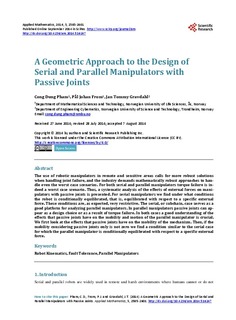| dc.contributor.author | Pham, Cong Dung | |
| dc.contributor.author | From, Pål Johan | |
| dc.contributor.author | Gravdahl, Jan Tommy | |
| dc.date.accessioned | 2015-01-13T12:31:00Z | |
| dc.date.accessioned | 2015-06-02T12:24:53Z | |
| dc.date.available | 2015-01-13T12:31:00Z | |
| dc.date.available | 2015-06-02T12:24:53Z | |
| dc.date.issued | 2014 | |
| dc.identifier.citation | Applied Mathematics 2014, 5(16):2585-2601 | nb_NO |
| dc.identifier.issn | 2152-7393 | |
| dc.identifier.uri | http://hdl.handle.net/11250/284412 | |
| dc.description.abstract | The use of robotic manipulators in remote and sensitive areas calls for more robust solutions
when handling joint failure, and the industry demands mathematically robust approaches to handle even the worst case scenarios. For both serial and parallel manipulators torque failure is indeed a worst case scenario. Thus, a systematic analysis of the effects of external forces on manipulators with passive joints is presented. For serial manipulators we find under what conditions
the robot is conditionally equilibrated, that is, equilibrated with respect to a specific external
force. These conditions are, as expected, very restrictive. The serial, or subchain, case serves as a
good platform for analyzing parallel manipulators. In parallel manipulators passive joints can appear as a design choice or as a result of torque failure. In both cases a good understanding of the
effects that passive joints have on the mobility and motion of the parallel manipulator is crucial.
We first look at the effects that passive joints have on the mobility of the mechanism. Then, if the
mobility considering passive joints only is not zero we find a condition similar to the serial case
for which the parallel manipulator is conditionally equilibrated with respect to a specific external
force. | nb_NO |
| dc.language.iso | eng | nb_NO |
| dc.publisher | Scientific Research Publishing | nb_NO |
| dc.subject | Robot Kinematics | nb_NO |
| dc.subject | Fault Tolerance | nb_NO |
| dc.subject | Parallel Manipulators | nb_NO |
| dc.title | A Geometric Approach to the Design of Serial and Parallel Manipulators with Passive Joints | nb_NO |
| dc.type | Journal article | nb_NO |
| dc.type | Peer reviewed | en_GB |
| dc.date.updated | 2015-01-13T12:31:00Z | |
| dc.source.pagenumber | 2585-2601 | nb_NO |
| dc.source.volume | 5 | nb_NO |
| dc.source.journal | Applied Mathematics | nb_NO |
| dc.source.issue | 16 | nb_NO |
| dc.identifier.doi | 10.4236/am.2014.516247 | |
| dc.identifier.cristin | 1154465 | |
| dc.relation.project | Norges forskningsråd: 192427 | nb_NO |
| dc.description.localcode | Copyright © 2014 by authors and Scientific Research Publishing Inc. This work is licensed under the Creative Commons Attribution International License (CC BY). http://creativecommons.org/licenses/by/4.0 | nb_NO |
